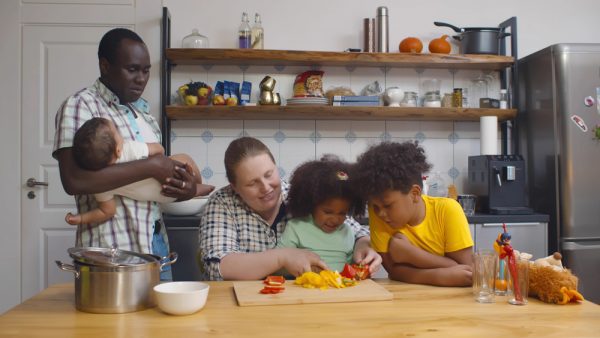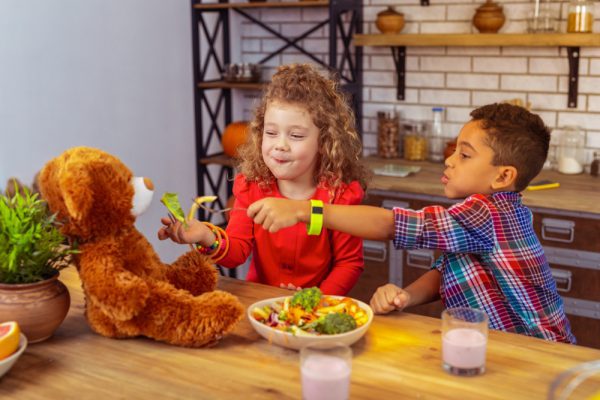
PARA ESPAÑOL, HAGA CLIC AQUÍ
Creating a welcoming and inclusive family dinner environment sometimes means dealing with the effects of trauma. Childhood trauma is more common than many parents realize; over 60% of adults report having experienced one or more Adverse Childhood Experiences (ACEs). While not every person who experiences an ACE will go on to exhibit the symptoms of trauma, many will. And for children who have experienced ACEs such as abuse or neglect, food insecurity, exposure to violence, instability in family life, or chronic mistreatment related to a disability, the aftereffects of that trauma can negatively impact ordinary daily rituals like family dinner.
Dr. Martha Straus, psychologist, professor, and author of Cool, Calm, and Connected, adds that while some children are born with feeding challenges related to neurodivergence, others may develop difficulties with eating and mealtimes due to trauma they’ve experienced. “I mostly work with kids with complex developmental trauma – kids who had early significant adversity in their caretaker relationship,” she explains. “The person who was supposed to be taking care of the child was neglectful or abusive. These are kids who have anxiety and depression. They end up with feeding issues, like difficulty handling utensils, and hoarding food. They have complicated relationships to food.” She also adds that sensory processing issues are common in children who have experienced trauma. “These kids aren’t integrated,” Straus says. “They’re overwhelmed. It’s not about control so much as it is about tactile or sensory defensiveness.”
And it’s not only kids who may be impacted by trauma at the dinner table. Dr. Archana Basu, a child and family therapist specializing in trauma and post-traumatic stress at Massachusetts General Hospital, points out that intergenerational trauma is a real issue for families to tackle. “Parental history of mental illness is one of the ACEs,” she explains. “Trauma can have a very broad spectrum impact. In a trauma-informed approach, we reframe all the symptoms to what happened in that person’s history that contributed to the symptoms. Dinnertime can be the most challenging time for parents who may have had a hard day, so that it’s difficult for them to help kids regulate. Kids might be oppositional, and that behavior can trigger so much in the parent, depending on their own history.”
In addition to ACEs, for some kids with learning and developmental challenges, inappropriate expectations at mealtimes can actually cause trauma. “I consider myself an activist,” says Naureen Hunani, RD., a pediatric and family dietitian who specializes in neurodiversity and is also the mother of neurodivergent children. “The type of children who have sensory processing issues, and parents aren’t informed about how to help them – parents may pressure them to eat foods when they have aversions to those foods, and that can cause a trauma. Some children have trauma from being in feeding therapy. Neurodivergent children are more likely to experience trauma because the world isn’t set up for them.”
Given that trauma responses at meals are likely to show up in foster and adoptive families, as well as with neurodivergent kids and any other person – of any age – who has experienced ACEs, it’s likely that many dinner tables are affected by trauma. So what can caregivers do to make dinner feel safe and welcoming for the whole family?

We spoke with a group of experts in child development, family therapy, and trauma-informed care. Here are their recommendations:
- Keep calm and don’t take it personally. “We treat kids differently if we think about this as a control issue,” Straus says. “If you think about it as overload, then caregivers will engage with less emotion. We really need to focus on adults being regulated at mealtime…Instead of saying that he’s doing it to manipulate or control, use the word relationship. What looks like oppositionality or brattiness is the way they are connecting with their caregiver around problems with transitions, anxiety, or fear.”
- Practice regulating emotions away from the table first. Both adults and kids may need practice to calm down and feel ready to engage at mealtimes. Straus recommends building those skills outside of mealtimes to begin with. “Mealtime is so complicated for traumatized kids because food is about intimacy and nurture,” she points out. “There are a lot of rules here in civilization!” Before expecting kids (and adults) to use regulating strategies to cope with their feelings in a mealtime environment, everyone can work together to develop some tools – like deep breathing exercises – they feel comfortable using at other times. “Parents can then say at the table, ‘You’ve practiced this before.’”
- Heal yourself. Basu adds that parental modeling is a powerful tool in helping the whole family to overcome trauma. “We are more often willing to do for our children what we can’t do for ourselves,” she remarks. “We can build on the love that parents have for their kids, but the paradox is that it’s hard to do for kids when parents haven’t had good care. Their needs are essential to supporting the ecosystem.” Dr. Basu recommends that parents engage in self-care practices, like therapy or self-reflection, which are also then an investment in their children. She notes that “Investing in one’s self is an intergenerational intervention. When parents experience therapy, and can model it, they can show that their kids can ask for help.”
She adds that caregivers will need to be aware of their own trauma history. “Recognize patterns (at the dinner table)…what does that bring up for you?” she counsels. “I encourage parents to reflect on their own challenges and strengths, and also build on their resilience.” - Build in gentle, comforting rituals. “Transition time is always difficult for kids in trauma,” Straus says. “Coming to the table is not so easy for these kids. What brings them to the table gracefully?” She lists ideas like giving comforting hugs before sitting down to eat, singing a favorite song together, standing together and stretching, saying grace or listing things you’re grateful for. But pay close attention to how the child reacts – they may not be ready for something like participating in a family prayer or gratitude exercise. “Maybe you could just hold hands and breathe together,” she suggests.
- Be as predictable as possible. “Any environment that is unexpected is going to be traumatizing,” Straus stresses. “As time goes on, if the environment is safe, dinner will happen. The unknown is what’s scary. For (many) traumatized kids, what was certain was danger and screaming at the table.”
Basu agrees, giving the example of a child who may have witnessed domestic violence. “That child would be hypervigilant at dinner, expecting that something bad is going to happen,” she says. “The blueprint for that child is that this is an unsafe time.” But violence or abuse aren’t the only traumatic events that may be triggering for kids at mealtimes. Basu also points out that when young children have experienced chronic neglect and instability, their developmental processes are interrupted. They don’t have the skills and experience necessary to understand what a regular, predictable family meal should be like, or to participate successfully.
Straus and Basu both stress the importance of creating predictability to help overcome kids’ ingrained fears. “This is what we’re going to have,” Straus models. “This is where we’re going to sit. How about you choose one food each night that we can have? When kids know what to expect, they’ll soon come to feel that it’s safe.” - Take the pressure off. For a child who’s struggling to feel safe at meals, many of the expectations caregivers might hold – eating what’s served, using basic manners, participating in conversations – aren’t reasonable. It’s crucial to keep dinner as low-pressure as possible for a while, so kids can gradually build their sense of security. Expectations around food and eating can be particularly tricky for people who have experienced trauma, Basu says. “Anything that is about control and emotional dysregulation can show up around food,” she reminds caregivers. Basu also brings up the importance of bodily autonomy and physical safety for a traumatized child. “What goes into your body, and who puts it in, can lead to mealtime challenges.” Caregivers may need to give kids extra input into what is served, and make a point of refraining from commenting on how much is eaten or not eaten at meals.
As for conversation and socializing at mealtimes, that may be a skill traumatized kids aren’t quite ready to master. Until a foundation of safety and comfort is well established, expecting kids to engage at the table may be unreasonable. Instead, Straus recommends having the kids help to create a comfortable environment. “I think music is underutilized,” she says. “You could do a DJ thing. Or have someone in charge of the sensory world – the music, the lighting. Or what if the dining room chairs are too uncomfortable? Maybe they’d be more comfy on the floor or a couch.” And Straus encourages caregivers not to ask too many questions in an attempt to get conversation moving. “A Q and A can be too intense,” she says. “Grill the food, not the kids!” - Deal with the child in front of you. Above all, when managing the effects of trauma at mealtimes, it’s vital to understand what each family member is ready for – and what they’re not. Dr. Robyn Thom, Child and Adult Psychiatrist at the MGH Lurie Center for Autism, encourages caregivers to only involve traumatized children in family meals to the extent that they’re comfortable. “Maybe the child could come by the table for dessert, or to tell a joke or a riddle. Maybe they could sit with the family for as short as a minute. You have to meet the kid where she is.”
Straus agrees, asking bluntly, “Why do we need kids to eat with someone? Some kids can’t do it.” They may be able to participate more over time, but if a child isn’t ready to engage in family mealtimes, no one will benefit from a struggle.
The bottom line is that when trauma affects the family meal, creating a safe and comforting environment is the most important thing – no matter what that environment looks like. But over time, with a lot of patience and consistency, it’s possible to build nurturing mealtime rituals. “Mealtime is such a central representation of our culture, traditions, and also our unique family histories. It represents feeling nourished, calmed, fulfilled, and satiated. It can be a collaborative process for parents and children, building on their cultural traditions, and family values and rituals,” Basu says. Caregivers can use that collaborative spirit to create a family dinner environment that includes, respects, and nurtures everyone.
